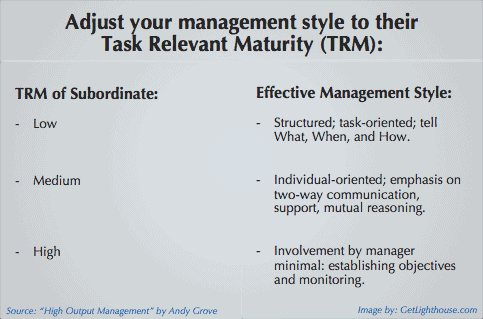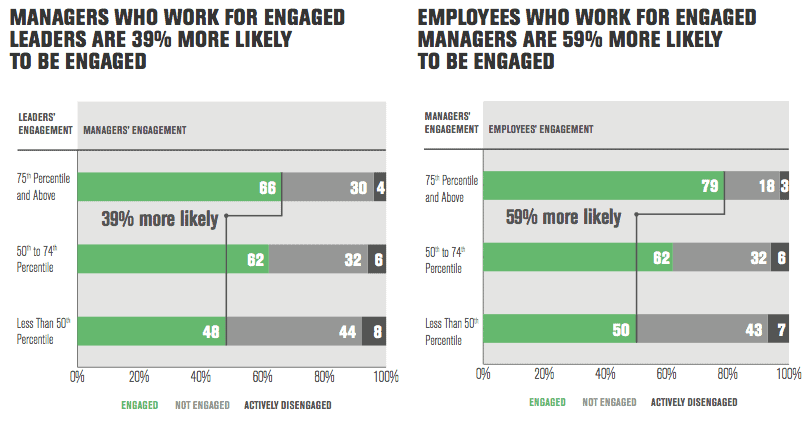Boss: "You're doing a great job with your team!"You: "Thanks!"Boss: "You don't mind if we go ahead and put a few more people on your team, right?"You: "Umm...."
Whether this is a conversation you've had in your head or one that's happened to you when talking to your boss, you know the hard truth:
As your team grows, it becomes geometrically more complex to manage your team.
As the image above from StackOverflow shows (original link is now dead, unfortunately), every person you add to a team adds more lines of communication than the one before, making management every time your team grows.
And as a manager, you're caught in the middle of this. As your team grows, there are:
- More tasks to delegate and outcomes to manage
- More communication issues to navigate, and
- More interests and motivations to consider.
The solution? You must learn how to develop leaders.
Table of Contents:
- Let go of your fears and desire for direct control
- Look for the leaders already on your team
- Sell them on the opportunity and set them up for success
- Coach and develop them
- Keep your one on ones with them
- Find out how they're doing and where to coach them most with Skip Level One on Ones
- Further reading

Why it's important to learn how to develop leaders
As your team grows and communication, delegation, and other issues build up, it becomes easy to have your soft skills slip.
Unfortunately, it's exactly then– when you don't give everyone the attention, feedback, and coaching they need– that you all lose.
Your team can easily slip into disorder or simply resentment for you as you break promises, forget what matters to them, and struggle under the growing stress.
At that point, developing future managers within your team becomes critical.
Developing leaders will not only make your life easier, but also help your company. A strong set of leaders reporting to you means that you fight fewer fires. It also means that team members previously reporting to you are taken care of as well as you did, or even better, by their new manager.
However, none of that happens by accident. Training leaders is done through coaching and preparation. Your guidance and support both before and after someone is promoted to manager makes all the difference.
By identifying potential leaders on your team and working to coach and develop them early, you can solve the issues you're facing from leading one, big team by breaking that complex architecture into smaller teams.

How many direct reports is too many? 10 direct reports.
We've had managers of all levels of experience and team size use Lighthouse to help them become amazing managers that get recognized.
The common pattern we've seen is managers struggle most with more than 10 reports. It's at 10 people that the complexity and demands become too great for even a well-trained, experienced manager.
Just look at how a team growing from 6 to 10 people causes the lines of communication to grow from 15 to 45:

And by 66 at employee #12 (!):

So how many direct reports should a manager have? Enter the rule of 7 direct reports.
But don't take my word for it, here are what some (very) well-known leaders have said:
- Jeff Bezos, CEO of Amazon.com, has a "2 Pizza Rule" which really translates to ~8 people, since a pizza is normally cut into 8 slices and 2 slices per person is a reasonable amount.
- Michael Lopp, author of Rands in Repose, uses the formula 7 +/- 3, which crucially takes into account how much time you could be committed to in 1 on 1s with everyone on your team.
- Tomas Tunguz, VC at RedPoint Ventures deep dives into the concept from many sources to conclude "roughly 7" and explores how "Span of Control" and "Span of Responsibility" impact it and lead to the rule of 7 direct reports.
Their consensus appears to be that double-digit team sizes are generally a sign of trouble for a manager, and ideally you'll follow the rule of 7 direct reports and start dealing with the issue before you hit 10 employees. That's why the first place to start is developing leaders on your team.

Keys to Creating Leaders When You have too Many Direct Reports
When you have too many direct reports, training leaders who can take some of that responsibility from you and manage their own team is key.
It can be difficult to let go of the control you're used to having. However, you need to do it if you want to solve the issues we talked about earlier.
Here's what to do to start developing leaders who can excel, even when you have too many direct reports already:

1) Let go of your fears and desire for direct control.
One of the first things you have to do is accept you can't have first-level contact with everyone on your team anymore.
This can be scary if you're used to setting the standard and pace on your team, and worry that without direct influence that will change. It shouldn't. As Jack Welch, former CEO of GE puts it:
"Before you are a leader, success is all about growing yourself. When you become a leader, success is all about growing others."
If you're going to grow as a leader and do the best you can for each person on your team, you have to be willing to give up that control. When your team grows too big you can't serve your team the way you were before. It's a pure numbers game; there are no longer enough hours in your day.
The only way to give your team the kind of leadership you aspire to is by creating leaders under you to lead as you do; they'll take responsibility for the day to day management of some members of your team, while you then work to develop them as managers.
Everyone wins when no one's plate is overflowing and dropping things that shouldn't be dropped or missed.
How to delegate effectively
It can be difficult learning how to best delegate as you begin to hand responsibilities to your new leaders.
How do you decide what is appropriate for your new leaders to handle? When should you be hands-on, and when should you let them run with things?
A helpful framework is Task-relevant maturity. Rather than always being too hands off, or micromanaging your team to death, it provides an alternative to give just the right amount of oversight and support for each person and task they're doing.

In his book High Output Management, Andy Grove describes task-relevant maturity as:
"How often you monitor should not be based on what you believe your subordinate can do in general, but on his experience with a specific task and his prior performance with it – his task-relevant maturity.
...as the subordinate's work improves over time, you should respond with a corresponding reduction in the intensity of the monitoring.”
By using task-relevant maturity as a way of identifying if your new leaders are ready to handle something, you can more reliably delegate with confidence. This makes the whole process of letting go of control quite a bit easier as you focus your efforts on the highest impact places.
However, before you can do that, you need to identify the leaders that are already on your team.

2) Look for the leaders already on your team.
When your team is too big you need help, fast. The situation is only going to get worse as time goes by and things build up, even if your team doesn't grow further.
The easiest solution is to identify and promote from within your team: they already know your culture, how the team operates, and your expectations. You also already have an existing relationship with them, which makes training leaders easier.
In a Wharton management study by Professor Matthew Bidwell, they found that external hires typically struggle compared to those that were promoted internally as they had, "significantly lower performance evaluations for their first two years on the job than do internal workers who are promoted into similar jobs.”
The study also found that external hires have, "higher exit rates, and they are paid about 18% to 20% more.”
Do you really want to take the risk of paying 20% more for someone who will perform more poorly, when you could reward your best people internally with promotions?

Promoting from within can be a big win.
Promoting from within on your team is a powerful, positive signal. Whomever you promote is a signal to your team what you reward; they're getting a new title, new power, and new responsibilities.
Of course, this choice is a double-edged sword.
Make sure they're deserving of that reward and that the behavior they display are things you want to see more of from others that want promoted and rewarded, too. Living your company's values is a good reason. Kissing up to you and playing politics is not, and will only lead to bad managers.
Managing a large team like a Pro: Consider promoting 2 people at the same time
Want to make a veteran move that can be a win-win all around? Consider promoting 2 people to manager at once to experience these added benefits:
- Reasonable Workload: Both managers can have smaller teams as they become acclimated to management, while still having a major impact on your workload (If you start with 10 reports, this means 4 people for each of them and a more manageable 4 directs for you, including them).
- Better Focus: With 2 new managers, all of your efforts to coach and develop them is multiplied. Every book you buy and lesson you teach goes to 2 people, magnifying your efforts often with as little effort as adding a second email in the To: field in an email or a 2nd quantity on a book purchase.
- Peer Support: Being a manager can be lonely and scary. By promoting 2 people at once, they can support each other as they have questions, learn new things, and look for someone facing the same challenges as them.
- Backup Plan: If one of them doesn't work out and wants to return to being an individual contributor, you aren't stuck starting from scratch and can return their team to you and the other manager.
No matter how you handle adding a manager or two to your team, you'll be heading in the right direction by reducing the number of direct reports you're juggling.
Further reading for you to learn more about promoting within:
- Make the case for why you should promote from within.
- Learn the pitfalls to avoid and what to do instead: The Top 10 Reasons Companies Fail at Promoting from Within
- As you grow your organization, learn the keys to Recognizing a Great Future Leader
- Hear the story of how one leader grew to become a CTO on our podcast episode: How to Rapidly Grow From Team Lead to Rising Leader

3) Sell them on the opportunity and set them up for success.
Some people may be excited by the prospect of managing, while others may need to be convinced.
Depending on their past experiences and biases, they may have different perceptions of such a role, so take the time to sell them on the virtues and benefits of the job. Just be mindful of people becoming managers for the wrong reasons, and choose who you promote wisely.
So what makes someone have the right qualities to become a manager? A few of the most important attributes we've seen that lead to great managers include:
- Empathy: Do they consider other people's opinions and viewpoints? Managers must understand the views of others, show good emotional intelligence, and avoid a one-size-fits-all management approach.
- Attention to detail: Do they produce quality work on their own or do you have to push them to maintain your desired standard? Managers set the bar, so be sure it's a bar you'll be happy with.
- Organized: Do they stay on top of their own work well enough you think they can do it for others? A disorganized manager will have a disorganized team.
- Leading: Have you seen them successfully take charge of a group before to tackle a problem? This shows they may have an interest in managing and the team is more likely to accept them as a leader.
- Growth mindset: Do they demonstrate an interest in growth and learning? Management has a long and steep learning curve they have to be interested in working on. It's also one of the mindsets that set great leaders apart.
If you find someone checks all those boxes, they'd probably make a good manager. Meanwhile, if it's a mixed bag, then these are exactly the things to discuss to see if they're interested in working on them.
Further reading for picking the right managers and key development areas for leaders:
- Read more about identifying the qualities of a good leader
- Learn how to set up new leaders for success with our guide: How to Become a Manager.
- Once they're promoted, have them start here: 7 Tips for First-Time Managers: How to Win as a New Manager
- And pick up one of these great books to help your future leaders grow: The Best Leadership Books to Buy Your New Managers

4) Coach and develop them.
Once they agree to the promotion and you set their team, your work is just beginning. You need to invest in their success by coaching and developing them.
Recent research by Gallup found it's quite rare for a manager to be naturally skilled in all the areas they must be to succeed, so you'll need to help them from day 1:

Sadly, despite this lack of natural ability, few managers feel supported today. The same Gallup study found that among American managers:
- Only 40% feel they have the chance to learn and grow at work.
- Only 33% feel someone at work encourages their development.
Don't be on the negative end of those statistics. The trade off of reducing your team size is that you should spend a big part of your newly-freed time investing heavily in developing your new managers to be successful.
Share the tricks, tips, and tactics you've learned along the way, and let them know what their new team needs to succeed.
How to develop leaders from day 1
Your experience as a manager is the best place to start when it comes to creating leaders who thrive.
Start by asking yourself: "If you could talk to yourself on the first day you became a manager, what would you tell yourself?" Then, teach them those things.
You know what has helped you most in becoming a good leader and can provide that to your developing leaders now as they're managing their new team.
Beyond those major lessons and tools you provide them, everyone is different, so it's important to listen to what your future leaders are telling you. Ask them what challenges they're facing so you can help coach them along the way.
And how do you support them best? By maintaining frequent, recurring one on ones, which will cover next.
Further reading on coaching and training leaders:
- Learn why modern-day managers need to be more than just managers, but also coaches: To be Great, Managers Must Become Coaches (Learn why & how)
- Use these questions to help you figure out how to better coach your team: 12 Questions for Your Team to Become a Better Coach at Work
- When you have great employees, you need to feed their hunger for growth to create win-win situations and retain them: 4 Ways You Can Fast Track Your Star Employee's Career
- Investing in training leaders is a key part of a senior leader's job. Learn how to pick the right course with - Ask Lighthouse: Leadership Training Courses and Their ROI

5) Keep your one on ones with them!
The following story is all too common: A friend of mine got promoted to managing his first team. Almost instantly, his manager stopped having one on ones with him, because they were "too busy."
My friend was all alone to figure out how to manage his team and suddenly had no outlet to get help, advice, and feedback.
As he told me via email:
"...I only recently started doing one on ones again with my manager after 3 months...they were tipped off by another coworker that I wasn't super happy day to day."
When you become a manager, you don't stop having questions and problems you need help with. In fact, now you have more!
You're in a new role where you have other people's problems to solve, too. Not having an outlet to get advice and understanding from your manager leaves you feeling unsupported and struggling. Worst of all, the issues affect everyone on your team, so it compounds.
Be the leader that supports their new manager(s), so they're not hung out to dry.

Use Task Relevant Maturity to identify how much time to invest in your new leaders
Even if your boss doesn't have one on ones with you, don't let that be an excuse to fail to support your new managers. Schedule the meetings and consider giving them extra time as they are getting comfortable in their new role.
As Andy Grove, former CEO of Intel wrote in High Output Management:
"How do you decide how often somebody needs [a one on one]?
The answer is the job- or task-relevant maturity of each of your subordinates. In other words, how much experience does a given subordinate have with the specific task at hand?
...the most effective management style in a specific instance varies from very close to very loose supervision as a subordinate's task maturity increases."
Use task relevant maturity as a way to gauge how much time you should spend with them. Then, as you understand their strengths and weaknesses, decide what responsibilities you give them.
Most importantly, remember: Even if they didn't need one on ones very often in their past role, they'll likely need them more right now as a new manager.

Invest more in your one on ones with them
If your managers aren't happy, it's unlikely their team will be happy, as Gallup found:
One on one meetings are the best tool you have to ensure your team is engaged and performing well.
This is just as true with your managers as an individual contributor. Ask your new managers good questions and really listen. Help them overcome challenges and know they have someone in their corner.
This is also a good time to make sure you're setting a good example on how to run a good one on one.
Use our one on one meetings template to make sure you're doing that and offer the template to them to make sure they're starting off on the right foot with their own one on ones as well.

6) Find out how they're doing and where to coach them most with Skip Level One on Ones.
Many of your direct reports will move from reporting to you to reporting to your new managers. Some may feel like great work friends that you don't want to lose your connection with.
Another type of one on one, called "Skip level one on ones" are a great way to keep in touch with everyone and get insights from the front lines that you're now a layer removed from. They also help you find out how your managers are doing so you know how to coach and support them best.
There are things you can pick up on by meeting with the direct reports of your managers that you might not be able to find out by meeting directly with them. The more you know, the better you can help guide them to become comfortable leading their team.

Skip level one on ones improve your organization's communication architecture
Having too many direct reports can hurt communication as you become a bottle neck and can't give everyone the attention they deserve.
By continuing to meet with those people who were once your direct reports, while delegating to your managers most things, you can improve your communication architecture. You get the best of both worlds: connection to everyone on your team, but not all the management responsibility day to day.
Keep in mind the commitment: Skip level 1 on 1s are usually done every 1-6 months with each person, so they're much less frequent than your typical weekly or bi-weekly one on ones with direct reports.
Before starting your skip level one on ones, preferably during one of your one on ones with your new leader, explain to them why it's a net positive to have you meet with their new team, and how you plan to use them.
Done well, skip level 1 on 1s will make you and your new managers both better leaders. You'll learn where your new managers are doing well and need more coaching from you, and you'll also stay connected to those further removed from you in the organization.
Further reading on skip level one on ones as a tool for creating leaders:
- Learn how to start skip level on on ones with our massive guide about skip level meetings.
- Not sure what to talk about? Here are some of our favorite questions you can use in your skip level one on ones: 66 Skip Level Meeting Questions to Improve Your Managers and Engage Your Employees
- Get even more tactics specifically on how to use skip levels to improve your managers: How to use skip level 1 on 1s to majorly improve your managers as a senior leader.
But wait! ...What if no one on your team wants to lead?
If you really see no one with the potential or interest, take a second look. Ask your team who they think would make a good leader.
If everyone still wants to stay in their individual contributor jobs, then you may want to look outside your team for help rather than forcing someone to do a job they don't want.
However, before looking outside the company, ask if another manager in your department has excess leaders looking for such a role. It's better to have a new manager that already is part of your company's culture take the lead than have to look outside the company.
If all else fails, hiring outside can work. Just be mindful of what they may not know by not having risen in the ranks at your company. Also, look for any potential culture biases they bring with them.
If it does come to this, consider how you can start growing your own talent; it's a better reward to show people they can advance in management and likely much cheaper than having to hire in all of your senior talent.

Free yourself by learning how to develop leaders
While you're feeling overwhelmed, just keeping your head above water with a large team, it can be hard to plan ahead. That's why it's so important to think about bold moves like promoting 2 new managers to free up your time.
By developing leaders and reducing your total number of direct reports, you help scale yourself. You also prevent your team from getting frustrated and leaving because they feel unsupported.
When you're ready to start developing leaders on your team, keep in mind these steps to follow:
- Identify new potential leaders
- Sell them on the opportunity of becoming a manager and set them up for success
- Coach and develop them to become great future leaders
- Continue having regular one on ones with them to support them in their new role (and consider meeting more frequently with them)
- Start skip level 1 on 1s to find out where to coach your new managers and stay connected to your growing organization
While not as great a leap as going from individual contributor to manager, learning to teach others how to do what you've done as a manager is another big challenge. Being deliberate like we outlined for you today can help make that a smooth transition for you, and a big help to your growing team.
Further reading on training leaders and managing large teams
We've written dozens of guides and how-to posts over the years helping managers learn to be great leaders. You may have even used some of them to help yourself.
Now that you're going to be a leader of leaders and need to learn how to train managers, the stakes are even higher. Check out our mega-guides and other posts to help you and your new managers improve, including resources to help you develop leaders and become a great manager of managers:
First, more on how to be a great coach to your team and choose the right managers:
- Employee Coaching: Why it Matters and How to Become Great at It
- 12 Questions for Your Team to Become a Better Coach at Work
- Who do you promote? 5 Qualities of a Good Leader (A useful guide for telling the difference between someone who has leadership potential vs. someone who isn't a fit)
Then, how to help your new managers become successful:
- 7 Tips for First-Time Managers: How to Win as a New Manager (Read this for a guide on what your managers should do when they're first promoted)
- New Manager? 3 Tips to Help You Succeed
- The 8 Best Books for New Managers on Leadership and Development (Resources for new/aspiring leaders to complement your coaching)
Lastly, how senior leaders can better manage their managers and build great organizations:
- 15 Skills Senior Leaders Must Master (Start here to get the 1,000-foot view of what it takes to be a manager of managers)
- Then read: How to Use Skip Level 1 on 1s to Majorly Improve Your Managers as a Senior Leader
- Leadership Lessons: How to Rapidly Level Up Your Leaders

What are the qualities of a good leader?
There are many qualities that make a good leader, but here are a few of the most important:
- Empathy and other interpersonal skills: Valuing others feelings and opinions (empathy), navigating the emotions of others, and knowing how to communicate with them are all examples of emotional intelligence, a set of skills that are synonymous with being a good leader.
- Self-awareness: Self-awareness is the other part of the emotional intelligence equation. Being aware of how you feel and think and having the skill to navigate those feelings effectively, especially around others, is a difficult thing to achieve in perfection, so any amount of such self-awareness is a sign of someone who would make a good leader.
- A growth mindset: To be a great leader and manager requires constant personal growth and development. Someone with an interest to learn and grow, and who believes they can get better could make a good leader.
Why is it important to develop leaders?
You must develop leaders, because as your team grows, it becomes harder and harder to effectively manage everyone yourself.
Each new person you add to your team adds several new lines of communication. The more lines of communication on your team, the more issues that build up, and the harder it can be to manage everyone and everything.
When you struggle to keep up with your growing team, your projects can start to slip and your team will miss the feedback and coaching that are so vital to their success.
By developing new leaders, you can remove yourself as a bottleneck, simplify communication, and take some of that added responsibility off your shoulders, fixing the issues you face with managing a large team.
How do you build team leaders?
Great leaders are built, not born. Your ability to build great team leaders is a really important skill to develop.
Here are some tips for you to become great at developing leaders:
- Identify team members with good leadership qualities: Including qualities like a growth mindset, showing empathy for others, and being a a good, active listener.
- Use regular coaching to develop their leadership skills: Provide resources to help them grow (books like these are a great starting point: 8 Best Books for New Managers on Leadership and Development), identify areas for growth, and offer regular feedback.
- Keep your regular 1 on 1s: They need you now more than ever, not less, even if they've already been promoted! Use task relevant maturity to identify how much time to invest in each developing leader and in what area.
- Use skip level 1 on 1s after they're promoted to see how they're doing and what their team thinks of them as their manager.
What are examples of leadership skills?
Here are a few of the most important leadership skills to be on the look out for when identifying potential leadership candidates:
- Empathy: Have they shown that they value and respect other's opinions? Do they care about their fellow team members well being and viewpoints? This and other emotional intelligence-based skills are critical to being a great leader.
- A desire to lead: It might seem obvious once said out loud, but many want the pay or prestige of leadership without actually having a desire to lead. Think about times someone on your team may have taken the lead in a group setting to tackle a problem as they could be a good candidate.
- A growth mindset: To be a good leader and manager means continual growth. Does the person you're considering show an interest in growing and learning? Becoming a manager is a career change, so make sure they're willing to invest in the lifelong learning necessary to be a great leader.
To learn more about good leadership qualities to look for in potential candidates, read our post: Who do you promote? 5 Qualities of a Good Leader.
How do you identify and develop future leaders?
Identifying and developing future leaders requires you to know what to look for (hint: it's not personal performance).
Here are some tips:
- Look for those who display leadership qualities already such as high emotional intelligence (both self-awareness and interpersonal skills), a growth mindset, and a level of consistency and accountability you'd like to see a whole team display.
- Use your regular 1 on 1s for coaching to help them develop areas they're weak in.
- Check out our guides to help new managers become great leaders such as 8 Best Books for New Managers on Leadership and Development and 7 Tips for First-Time Managers: How to Win as a New Manager.
- Then, once they're promoted, use skip level 1 on 1s to check in with their team and learn how they feel their new manager can improve.
How do leaders develop other leaders?
Great leaders are great coaches. That's important to know because, just like becoming a manager requires a mindset shift, becoming a senior leader requires another kind of shift in thinking. To develop other leaders and effective managers, you can't just lead, you need to understand what makes a great leader.
The best way to develop other leaders is then to:
- Pass on what you know, especially if you're still learning, and
- Give your managers resources to learn from other successful leaders (books are great for this)
- Don't assume that just because they're a manager now that they don't need your help anymore. When you first became a manager, how did you feel?






